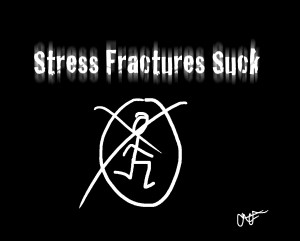new posts in all blogs
Viewing: Blog Posts Tagged with: cross training, Most Recent at Top [Help]
Results 1 - 5 of 5
How to use this Page
You are viewing the most recent posts tagged with the words: cross training in the JacketFlap blog reader. What is a tag? Think of a tag as a keyword or category label. Tags can both help you find posts on JacketFlap.com as well as provide an easy way for you to "remember" and classify posts for later recall. Try adding a tag yourself by clicking "Add a tag" below a post's header. Scroll down through the list of Recent Posts in the left column and click on a post title that sounds interesting. You can view all posts from a specific blog by clicking the Blog name in the right column, or you can click a 'More Posts from this Blog' link in any individual post.
.jpeg?picon=3498)
By: Cait,
on 9/25/2014
Blog:
Cait's Write...
(
Login to Add to MyJacketFlap)
JacketFlap tags:
tips,
running,
motivation,
art,
goals,
nutrition,
injuries,
training,
cross training,
Add a tag
Within every runner live the Yin Yang twins…the grinder and the ice-cream loving, sloth who lives to watch cartoons. We’ll call the latter the ‘recovery champ’.

While I jest, because it’s not just ice cream they love but pizza, donuts, burritos, french toast [insert runger fantasies here], there is truth to it.
In order to run hard you’ve got to allow your body to recover just as ‘hard.’ It often takes runners awhile to learn this, often the hard way. Typically everyone goes through the stage where they race every run, a run doesn’t count unless you’ve maxed out, right?!  While this usually leads to improvement in the short term, eventually going hard every day will lead down the road of an injured, over-trained, mess.
While this usually leads to improvement in the short term, eventually going hard every day will lead down the road of an injured, over-trained, mess.
Without adequate recovery you’ll be too tired to actually run fast. Easy days are important, as are other ways to speed up your recovery. In order to NAIL the days that count, your hard workouts and races, you’ve got to ensure your muscles are able to rebuild and repair themselves between hard sessions.
So there IS an excuse to laze around in your sweats and hit up a Netflix marathon.  Recovery is more than just an easy day too, for most mortal runners of the world running isn’t your job so lifestyle choices and how you spend the non-running hours of your day will play a big role in your ability to recover.
Recovery is more than just an easy day too, for most mortal runners of the world running isn’t your job so lifestyle choices and how you spend the non-running hours of your day will play a big role in your ability to recover.
Even for the elite runners, they are continually looking for ways to improve their recovery…because chances are there is ALWAYS room for improvement somewhere.
Take a look at your own habits and look for areas you know you could be better at. I’ve made a handy little checklist to give you some ideas of where to start:
* Make sure your easy days COUNT: rely on effort, don’t wear a watch if you have to, you should be able to hold a conversation between breathes on these runs.
* Proper Workout Scheduling: every runner needs to learn their body and how many hard workouts they can handle in a week. As we age we need to learn how to adjust, that may mean turning your ‘week’ into a 10 day cycle.
* Cross Training: I did a whole post HERE about how to maximize training if you know your body can’t handle too many running miles. Cross training on your easy days or as a ‘second run’ can help keep you healthy and allow for an ‘easier’ workout for recovery purposes.
* 30 Minute Refuel: eat a combo of protein and carbs IMMEDIATELY after your runs…especially your hard workouts. Miss this window and recovery rates drop upwards of 60%.
* Nutrition: eating to perform means opting for quality foods, timing them around when you run, and ensuring you get enough nutrients. This means protein, carbs, healthy fats, and overall enough calories to fuel your training demands. Eating to perform also means LIVING, if you’re training hard enough and want a freaking donut, you’ve earned it. Balance comes into play, so I’ll use the analogy of a silo. Fill your body with all the quality nutrients first, then any extra ‘energy demands’ needed to fill the rest of the silo should be up to you. A world without french toast is a dark one.
* Self massage: whole post on that HERE, flush out that lactic acid, keep your body knot-free.
* Hydrate: this is incredibly important regardless of the season, obviously hotter weather requires you to hydrate more and with electrolytes but even in a snow storm you’re losing moisture. Drinking after massage is also important to flush out all that ‘junk’ worked out of your muscles.
* Stretching: tied into self-massage, stay loose, limber, and avoid injuries.
* Time on Your Feet: it’s draining on your legs and energy-zapping, if your job requires you to do lots of ‘work’ know that you may need to adjust your training or learn how it affects you.
* Time on your butt: yea it’s important to rest, BUT office jobs can lead to problems too…too much sitting leads to weak glutes, tight hamstrings, and reduced blood flow. Not good for recovery, so be sure to move around and at least walk around a bit between Netflix marathons.
* Sleep: while I may leave this one for last, this is HUGE!! Sleep is when the body REALLY restores and repairs itself. Skimping on sleep will hamper your recovery, professional runners guard their sleep time and usually take naps too. Make sleep a priority. For those with sleeping problems and insomnia (ugh, join the party!) look for ways to improve the situation or figures out what can sometimes help. Restless nights add up to tired legs and eyebags. 
I think that’s a solid list of ways to improve your recovery habits. Start cracking! To let that grinder perform at it’s best, that recovery-er needs to be doing it’s job right too! 
—–
New ART is listed and available for prints on my page there…restructured to make things a little easier. As always, anything not shown, email me a request and I’ll get you a print.
—-
1) What are some ways you make recovery a priority?

.jpeg?picon=3498)
By: Cait,
on 8/30/2014
Blog:
Cait's Write...
(
Login to Add to MyJacketFlap)
JacketFlap tags:
tips,
running,
goals,
training,
cross country,
workouts,
hill running,
treadmill running,
cross training,
Add a tag
Runners are constantly climbing. It’s in our nature to always have a goal we’re working towards, always wanting to push ourselves to do better. Whether it be chasing new PR’s, challenging yourself to expand your race distance range, or even after we’re past our ‘PR-PR’ years, redefining the times and bests (weekly, yearly, masters, etc.) bests.
Diversity. Fitting as it is now cross country season that we talk about diversifying your running and climbs. Cross country thrives on both. I’ve done posts on just how awesome hills are at improving your strength and power, which translates to speed. What I haven’t talked too much on are prolonged hill climbs.

The long climb, yup. We’re talking taking your tempo runs to the trail, or inclined treadmill if you don’t have a stretch long enough outside. I’ve previously featured the man-beast that is Michael Wardian and he’s no stranger to treadmill running.
While he’s one of the World’s best ultra and trail runners, a major chunk of his miles are done on the treadmill so he can fit his runs in around his family’s (namely his kids’!) schedules. Wardian loves a good, long climb.
He makes sure to do hill work a few times a week and, “for me that means hours of running up vertical inclines, sometimes fast, sometimes just a long grind, but always pushing to get better.” Wardian is an ultra runner after all.
Another big fan of prolonged uphill runs is Sage Canaday, a staple workout for him is an uphill tempo run. Canaday is another World leading ultra runner [check out my feature on him HERE], residing in Boulder, CO he has no shortage of trails to mountain goat up.

Yo, that’s my rockstar dad running 50 miles! :)
Even if you’re not one of the best in the World, taking advantage of prolonged hill climbs will benefit you.
Coach Brad Hudson of the Hudson Training Systems, coaching both elites and all levels of runners, regularly incorporates uphill tempo runs for his runners.
Try It:
Take your next scheduled tempo run to a hill, keep the distance the same and adjust based on effort. [Captain Obvious: Your times aren't going to mean much, so go off of effort.] I’d suggest going 4-5 miles.
No hill? No problem…take it to the treadmill. For a moderate climb set the grade to 4% for your tempo run and again, go off of effort. Do your warm-up and cool-down at 1.5%, as that’s the equivalent to running outside on the flats…after you jack that incline up and finish your tempo run, upon lowering you’ll see just how much ‘easier’ the same pace will feel at 1.5%!
If you’re looking for a steeper incline, Captain Obvious tells us you can just elevate the treadmill. 
Another twist courtesy of Coach Hudson would be to make your hill climb tempo progressive, begin the workout at a 2% grade and have it up to 6% by the time you finish.
Life’s a climb after all. For runners, we take that both figuratively and literally. 
——–
More workout posts HERE
Need some motivation to get ‘er done…look HERE
Sweat hard, recover hard… #SweatsintheCity style, Baby!
——–
1) Are you running cross country season?
2) How do you incorporate hill work into your training?
3) Have you done incline tempo/threshold work?

.jpeg?picon=3498)
By: Cait,
on 8/13/2014
Blog:
Cait's Write...
(
Login to Add to MyJacketFlap)
JacketFlap tags:
tips,
running,
motivation,
goals,
injuries,
training,
exercises,
stretching,
cross training,
training tips,
Add a tag
Being patient sucks. Waiting for what we want isn’t fun, but the reality is that often times we are forced to wait. Even more often is it that rushing things will ultimately leave us more frustrated in the long term.
As runners, wouldn’t it be awesome if we could just lace up and make our next race/workout/run a PR? If only, right?! The natural tendency to want those faster times and better fitness TODAY is the breeding ground for injuries, overtraining, and slowed progress. Beautiful irony there, right?

Every runner has been guilty of it, and hey, some things you just have to learn yourself the hard way. (Sometimes a few times to really NAIL that lesson home.) Being patient sucks…but we need to learn to embrace it.
Yikes. Where’s the spoonful of sugar to wash that down? Well that comes when you actually ARE patient and watch your goals materialize…eventually.
The sweetest victories only come after enough struggle and work, after all.
Convincing yourself to wait it out and be patient is tough and often an on-going battle. Incidentally a large part of being able to stay patient comes from confidence. How so?
Being patient means BELIEVING in yourself, what you’re doing, and the process. A runner who lacks confidence is the one who tends to rush things, an example of that is going out way too fast in a race. It takes MORE confidence and patience to go out controlled and then pick up the pace, and close fast. A runner who tries to ‘make a buffer’ by going out too fast is subconsciously affirming they are going to slow down. See how that’s not a good way to think? It takes more confidence to be patience, wait, and then respond to your competitors (or go faster) as the race progresses.

New runners can be a little less than confident in their abilities as they venture into a new sport. That’s natural, but it’s dangerous to go into information overload and want to do EVERYTHING and anything they read about training and incorporate it right away. This usually leaves them injured or too sore/tired that they lose any desire to continue running.
Even if you’ve been a runner for years and years, it’s quite easy to fall into the same trap of wanting to add in XYZ all at the same time…to rush the process. You know what, the same road leads to the same place.
Avoiding injuries and reaching your best takes time. Waiting is hard and it can suck at times, but if you try and rush things too fast it will, in the end, it will suck even more. (nightmares of time off or on the cross trainer missing your race should help keep you patient.  )
)
There really ARE tons of training elements to keep you improving and progressing through the years. This should be exciting news, it’s just imperative not to rush things.
I will say that the BEST way to stay patient and keep yourself honest on the right track (in the moment it can be REALLY hard sometimes to know you need to be patient) is to a have a coach. If not a coach then at least an educated source or training group to bounce things off of. Today it’s important to recognize the source of the training advice you’re getting and if it’s actually got merit.
Being patient can suck in the moment, but eventually it is oh so sweet.
—-
More posts on training tips HERE
Some of those ‘extra’ training elements to help you improve: CORE STRETCHING DRILLS
—-
1) How do you remind yourself to stay patient when you really don’t want to wait?
2) What keeps you honest/patient when it comes to your training?
3) When is an instance where NOT being patient made things much worse for you?

.jpeg?picon=3498)
By: Cait,
on 8/4/2014
Blog:
Cait's Write...
(
Login to Add to MyJacketFlap)
JacketFlap tags:
tips,
running,
motivation,
injuries,
training,
stretching,
core,
recovery treatments,
cross training,
Add a tag
Nothing unites complete strangers more than discovering they are both, in fact, injured runners. Because let’s be honest, no one REALLY understands the agony us runners go through when we’re deprived of our ‘fix’. Miles give us endorphins, take those out of the equation and you do the math. It sucks.
Run long enough and you’ll get injured. It’s a fact. Darn these humanoid bodies not quite engineered to put up with everything we want them to do in training and racing. This isn’t to say there aren’t plenty of ways we can limit our injuries, and yes, us runners can be quite stupid sometimes in getting ourselves injured, but at a certain point you will get injured despite doing everything you can do right.

But don’t think of that last line as a free pass to just go willy nilly, throw all caution to the wind then, when you do wind up hurt, pretend you have no clue why. Let’s start with the stupid:
• Denial: Oh we’re the queens and kings of denial, us runners. “It’s not really that bad, it doesn’t hurt that much” thought as we hobble around the house in search of more ice.
• Grimace Face: We know running hurts, but when every stride sends a shooting pain (which you’re of course denying exists) your face gets twisted into a grimace that would make Frankenstein look beautiful.
• Random Prayers: You go to bed praying you’ll wake up and magically everything will just go away. No other logic there but a runner clinging to any shred of hope.
• Eff It, I Can Finish: Said during any run or workout, you’ve denied the shooting pains for as long as possible, somehow still believing that if you just muster on through this run, get done, things will still be peachy keen.
Clearly we all have to learn from our stupid mistakes. We’ve all been there, hopefully the older we get the wiser we get. Because let’s be honest, denial doesn’t change the situation.
Over the stupid, here are the proactive:
• Self-massage: Runners if you’re not in a love/hate relationship with your foam roller, I urge you to get cozy with it. Give him or her a name even.
• Stretch: Static and dynamic stretching post run.
• Core and Strength: Strengthening your core and WHOLE body to limit the compensation issues resulting from weak muscle groups.
• Ice, Smart, Recovery, Etc: You know the drill there.
• Form Work: Ties right into strength, run more efficiently and you’ll be doing less wear and tear on your body.
I’d like to take a minute to emphasize that if you’re not doing some kind of core or strengthening routine you’re not addressing issues that WILL eventually get you injured. Not a single runner in the world pops out perfectly balanced and with perfect biomechanics. Most runners have tight hips and weak glutes, just two major issues that cause many a runner heartache come injury time. What’s more is there tends to be a little too much emphasis on stretching alone. YES you need to stretch, but save some of that time for core work because you can’t stretch away a weak muscle group if you get my gist. I’m not talking about hitting the weight room like a Jersey Shore’r (a little dated reference but I was watching a comedy earlier that did a bit on that so it’s on my mind), and in fact many of the most effective exercises for runners can be done with bodyweight or with a swiss ball. I did some posts HERE with some of those.
Crash Course: Mentally Surviving an Injury
Back on topic. So you do your preventative but like I said injuries will occur. When you’re laid up you’ll most likely experience a few emotions.
• Rage: Like wanting to literally rip off your leg just so you can smash it against a wall, infuriated that ‘it’ let you down.
• Remorse: I abstain from the word depression, but it’s like a hair away.
• Anxiety: Is this going to EVER end? Will I EVER be able to run without pain, ever? Getting up in the middle of the night to go to the bathroom and you sorta ‘test’ jog down the hall, “Crap! Still hurts!”
• Envy: Oh that lovely runner envy. Daydreaming about hopping out of your car and slapping in the face the person you see running down the street. It’s not something to be proud of, but every injured runner thinks it. 
• Rage: Yea, you circle on back to rage.
I blame it on the lack of ‘proper’ endorphins for our crazy train ride of emotions and THESE are the things that our family and friends tend to have a hard time grappling with. To every runner who’s gotten, “But it’s just running” and you have to literally hold your arm down from punching that person in the face…yea, that’s a normal runner reaction.
The thing is, while I like to joke and jest and be comedic about Runner Rage (it’s totally legit and an excuse that I think should hold up in court, “Sorry, I’m not fully in control of my actions, I’m a runner who’s not able to run at the moment”) I’m also the first person to say this:
“Force that positivity down. Choke it down and keep it there. Fake it.”
Yup! That’s the only way to get through an injury. You keep yourself OUT of that depressive and overly-anxious mindset because if you don’t you’ll stay right there…stuck.
How I deal with Runner Rage is making fun of myself and being sarcastic. Rather be laughing than wallowing in sadness. What also helps is to feel proactive during your recovery meaning: cross train, core, massage, find out where your weaknesses are and target them. Come up with a recovery plan and start the execution. The other really important thing is:
Take it ONE day at a time.
Think only through the day. Because thinking of weeks and weeks of the elliptical or bike is, well, depressing, right? So just get through the day.
And there is always this: you’re not alone. There are other injured runners out there. And there are non-injured runners who know EXACTLY how you feel and what you’re going through and they sympathize and are sending you heal up fast vibes!

A headline caught my eye recently: “Be a better runner without running.” *About face* Now I respect the news outlet that ran the article but the snark in me can’t resist thinking, “This kind of thing belongs in Runner’s World next to the column ‘How to get faster in your sleep!’”

Track dreams…but you still need to actually run on the track too. ;)
In seriousness though, yes there are ways to improve your running and get faster that aren’t running. HOWEVER, these are thought of
like ‘extras’…you still have to run.
Everybody and every BODY handles a different amount of volume and quality. Not everyone can log 110 miles per week, with a hard speed session, endurance session, and long run in a 7 day cycle. Some people can run 170 miles per week just fine, others get hurt going over 50…waaah-waahh it’s not fair but that’s how it is.
Know your body. Know your limits and maximize them. Just because you can’t RUN more than 50 miles per week does not necessarily mean you can’t beat the runner doing twice your volume. Enter QUALITY.
Here are a few quick tips on maximizing your training if you’re a runner who is a little more ‘fragile’: (ie: improving your running with running less and doing other stuff)
* Extend Your ‘Week’: By this I’m talking about viewing your training cycle as 9-10 days rather than the standard 7. Meb Keflezighi has talked about doing this as he’s aged, and many masters runners work off of a longer training week. This allows for more recovery between hard workouts.
* Rule of 10 and Baby Steps: If you’re injury-prone already you know you need to BABY your body a bit. Only increase your miles by 10% each week. Then be honest with what your mileage ‘max’ is. If you start getting extra creaking when you kiss 50, stick there and supplement with extra cross training instead of miles.

* Swap Your Easy Runs: Plan your miles for the week and ‘save’ them for your hard workouts and long runs. Those are the days that will give you the most bang for your mileage buck. Cross train on the easy days; to be honest the benefit of easy days are mostly just getting the steady cardio in…you can do that running or cross training. The former is just a lot easier on your body.
* Seek Soft Surfaces: The pavement is harder on your body than the trails, track, and treadmill. Seek these softer surfaces. Also know that lots of downhill running exponentially increases the impact on your joints, so steer clear of huge, sharp downhills.
* Get More Efficient: Most injuries are a result of a weakness and muscle imbalance. Fix those and you’ll be running more efficient and most likely be able to handle running more. All the more reason to fix your form, get a stronger core, and solve why you might be stuck in a vicious cycle of injuries.
* Fitter With Cross Training: Ideally you want to be doing your hard workouts as running because this will translate the best for racing but you’d be amazed by how fit you can stay with cross training workouts. So if you have to do some of your ‘running’ workouts on the cross trainer don’t freak out and remember it all comes back to effort. Go hard, get your heart rate up, feel the burn in your legs and lungs, and you’re getting work done.
Not EVERYTHING that will get you faster comes from running more miles. Think outside the box, learn your body, and maximize your potential.
Though the snark in me still has to end with this: “but, duh, you still have to do some running.” 
——-
More articles on cross training and workout ideas!
More articles on injuries, recovering, and how to prevent them!


![]() While this usually leads to improvement in the short term, eventually going hard every day will lead down the road of an injured, over-trained, mess.
While this usually leads to improvement in the short term, eventually going hard every day will lead down the road of an injured, over-trained, mess. ![]() Recovery is more than just an easy day too, for most mortal runners of the world running isn’t your job so lifestyle choices and how you spend the non-running hours of your day will play a big role in your ability to recover.
Recovery is more than just an easy day too, for most mortal runners of the world running isn’t your job so lifestyle choices and how you spend the non-running hours of your day will play a big role in your ability to recover.![]()
![]()









